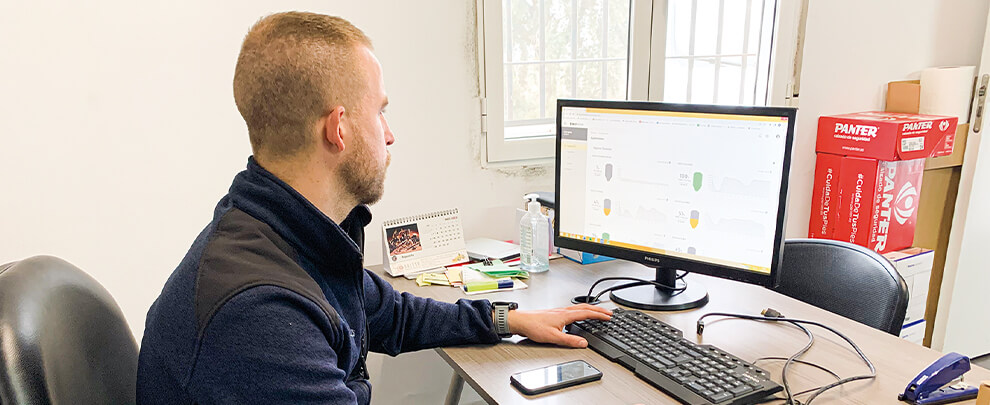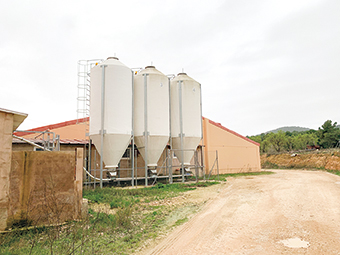Blog
Blog

A. Iniesta: “The Silotronic allows you to fine-tune your feed needs”
07 of July of 22 - Success stories
Offspring of a family of farmers, in 2011, Aitor Iniesta decided to join Expoinor, the family business, and wager on expanding the endeavour. Thus, in addition to giving continuity to the fattening farms, he built a breeding farm with 1,000 sows, which in 2017 expanded to the 3,000 sows it currently has. After years of relying on Rotecna and its products, in 2022 he has installed a total of 39 Silotronics, a real-time silo level control system, to optimise the feed and fuel consumption of all its farms and improve the logistics of raw material orders with the feed mill and the integrator.
Why did you decide to devote yourself to livestock?
My grandparents and parents have always been committed to pig breeding and agriculture, so I continued with the tradition. Until I joined the family business, they had always been devoted to fattening and, it was when I joined, in 2011, that we started with sows. First with 1,000 breeding sows and, in 2017, we expanded to 3,000 sows that are the ones we currently have. We also have 13,500 spots for transitional piglets from 6 to 20 kilos and 9,000 fattening spots.
You have recently installed Rotecna’s Silotronic real-time silo level control system on your farms. Why did you decide to install this system?
Mainly to control the stock of the raw materials we have on farms, not only feed but also fuels. It is a way to calculate the consumption that we have within each farm daily, supervise possible excesses of consumption that we may have in some warehouses, optimise the management of feed orders with the factory and the integrator, and even the fuel orders for the farms.
How many Silotronics do you have installed?
In total, we have 39 Silotronics installed on four different farms; 19 on the breeding farm, 7 on the transition farm, 7 on one of the bait farms and 6 more on the second bait farm.
What is the daily work you do with Silotronic software?
It is very simple, we open the application and, farm by farm, we see the status in which the silos are and export the information in an Excel sheet to analyse the consumption. On the other hand, we also have the possibility of creating alerts so that if the volume in any of the silos falls below a certain level, we receive a notice via email.

Aitor Iniesta at the breeding farm in Utiel (Valencia). Photo: Rotecna.
What are the main advantages you would highlight from working with Silotronic?
For me, one of the main advantages is a matter of time, since you do not have to manually check each of the silos, and even a matter of safety, since we avoid certain accidents that can be caused when climbing the silos. Finally, as it is a computerized system, we greatly reduce the possibility of any human error. We are talking about that we have 39 silos that, if you want to check daily, a person has to go silo by silo, with the consequent error that can be generated at the time of communication between the person who looks at it, the one who receives the information and the person who places the order. In this way, through the Silotronic it is a very fast and visual way to know in what state all the silos are, the consumption I have (of feed and fuel) and even when I can last with it. In addition, all this information can be shared with the feed mill or with the person who takes care of the orders within the feed mill or integrator, so the logistics of all raw materials are simpler and more comfortable.
What are the benefits of having silo data in real-time?
The main advantage in our farm I see in the feedlots, especially at the end of breeding, when you are already taking out the animals because it allows you to fine-tune what feed needs you have per day. Knowing the number of animals you have left and the consumption per animal daily, you can fine-tune the final order of feed so that you do not have a surplus of feed and have to remove it with a sucker with the economic cost that this implies for the farmer, or have to leave the feed in the silo and that this can affect the subsequent breeding. As for sow farms and transition, the Silotronic is also very useful, but in this case, we use it more for fuel control and more now that it is very expensive. In this way, we can see if with any adjustments we can achieve an improvement in daily fuel consumption within the farm or not. Even so, sometimes if we ask for fuel from a factory other than the usual one, we can see, by the consumption in periods of 6-8 days, if it meets the same standards at combustion or not.
In terms of costs, are there economic savings when working with Silotronic?
Beyond the saving of the time spent reviewing the silos, which with the Silotronic is very little compared to the manual method, what can help you most to have an economic profitability thanks to the use of this system, is the decision-making capacity that it offers you regarding what you can do on the farm to optimise feed and fuel consumption.
Is Silotronic’s software easy to use?
It is a very simple and intuitive system, I do not see any complexity. In the computer program and the app, everything is very well separated by farms, types of feed, and fuels … Then you can see how all the silos are doing, and sort them by number or names of silos. You have many options. I, personally, always check the data from my mobile, but it can also be done from the computer, from a tablet or on any device with an internet connection.
Do you share the data with the integrator you work with?
The program allows you to create several users with different permissions to access and modify the information. In this sense, my user would be the administrator, that is, the one who has access to change any parameter of the system: weighing, volume, silos, farms … and then some operators of the farm and the integrator have specific profiles that can only access the data of the silos of one, two, three or four farms. In the case of the integrator, accessing the state of the silos helps them, especially, to complete the last days of an upbringing until closing. Until now, I used to tell the integrator the amount of feed I thought had been left over, now they know exactly how much feed has been left in the silo, so they can make the closure with more accurate data.

Image of the silos with Silotronic installed. Photo: Rotecna.
What other products has Rotecna installed on your farms?
We have several Rotecna products. A few years ago, we set up the Tecnapur system for the management of livestock droppings, we also have the Dositronic electronic feeding system in farrowing, and then hoppers, feed distribution systems, dispensers, floors … A bit of the whole range that Rotecna offers.
In general, what do you value about the Rotecna brand?
What farmers always value in any company is the balance between price and quality. For me, the quality result with Rotecna has always been very good and in terms of price, satisfactory. In addition, the technical service offered on products that require a little more assistance is very good and fast. If you have any questions they answer immediately.
Health related, what are your main concerns?
At the national level, we are all concerned about ASF (African swine fever). At the moment, in Spain, we have not had any cases, and that it continues like this and, in the particular field we work in so that all the farms we have stay free of PRRS, which is one of the main concerns for production purposes. Right now, we are also concerned about the reduction of zinc oxide, to see how the transitions are going to develop, the percentages of casualties … However, in the end, if we have learnt something in the pig sector, it is that when something goes wrong we also know how to recover.
In the face of health threats, what biosecurity measures do you have on the farm?
Beyond the measures known to all, which I would say that most of the farms comply with, we try to make sure that no one enters the farms if it is not necessary, and, in case they have to enter, try to make it on Monday and ask for a minimum period of 48 hours without having been in another farm. Then, we do not have any other farm within a radius of a kilometre and a half around our farms, we have double perimeter fencing. Both in quarantine and on the breeding farm there is a double disinfection arch, and the external breeders that come to us spend four weeks at least in quarantine, etc. In the end, it is a question of trying, as far as possible, that the animals on the farm are protected from any external conditions. So far, in the eleven years that we have been working with the breeders, we have never had a health problem. Let’s hope it stays that way.
What future challenges do you face?
At the moment, in the current situation, we do not foresee any new investment in growth, so we will work to make sure that everything continues as before, stable; although the future will tell.






